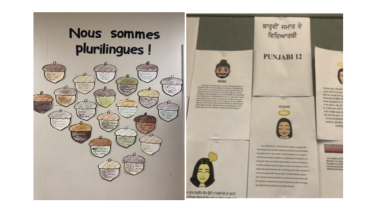
Opening Minds and Hearts
Empowering language proficiency and fostering global citizenship in the additional language classroom
“To learn a language is to have one more window from which to look at the world.” - Chinese Proverb
Learning a language is an incredible opportunity to develop intercultural competence and is not solely limited to learning a new set of vocabulary and grammatical structures. Across our District, students in Punjabi, French, Spanish, Japanese, and German language classrooms are developing their speaking, listening, reading, and writing competencies in the target language, while participating in rich learning experiences that promote multicultural awareness. Through the cultural component of our language curriculum, students are exploring, making connections, and interacting with other languages, cultures, and communities around the world, while drawing upon their own language(s) and culture. This connects with the First Peoples Principles of Learning: Learning requires exploration of one’s identity.
It is an exciting time to step into an additional language classroom! Our K-12 students are currently diving into action-based tasks and engaged in collaborative inquiry-based language learning activities, while building real world skills. Some multimodal examples that promote and affirm identity, while supporting language learning in the classroom include students:
- writing and sharing their identity texts,
- creating dual language books with Book Creator,
- writing and sharing plurilingual texts (songs, poems, stories) with students from another school site,
- teaching each other to count in English, Halq’amélem, and Punjabi,
- exploring the connections between First Peoples communities and the French language, such as through an interactive Google Meet with musicians Twin Flames then sharing their reflections in a blog, and
- participating in virtual pen pal exchange with Flipgrid or the integration of Nearpod Interactive lessons and 3D virtual field trips.
As well, our language teachers are collaborating and exploring rich, culturally responsive, and inclusive resources and instructional practices to inspire, engage and support transfer across languages. As we recruit and celebrate our students’ skills, cultural and linguistic growing identities, we are also supporting their development of a global mindset- to be able to see the world through the eyes of their neighbor with an open heart and an open mind.